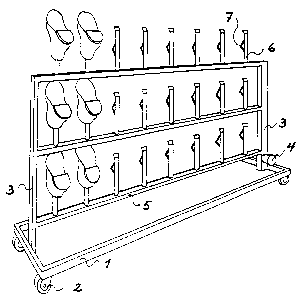Some of the information on this Web page has been provided by external sources. The Government of Canada is not responsible for the accuracy, reliability or currency of the information supplied by external sources. Users wishing to rely upon this information should consult directly with the source of the information. Content provided by external sources is not subject to official languages, privacy and accessibility requirements.
Any discrepancies in the text and image of the Claims and Abstract are due to differing posting times. Text of the Claims and Abstract are posted:
| (12) Patent Application: | (11) CA 2150002 |
|---|---|
| (54) English Title: | STAND FOR TREATMENT OF FOOTWEAR |
| (54) French Title: | SUPPORT UTILISE POUR LA FABRICATION DES CHAUSSURES |
| Status: | Deemed Abandoned and Beyond the Period of Reinstatement - Pending Response to Notice of Disregarded Communication |
| (51) International Patent Classification (IPC): |
|
|---|---|
| (72) Inventors : |
|
| (73) Owners : |
|
| (71) Applicants : |
|
| (74) Agent: | SMART & BIGGAR LP |
| (74) Associate agent: | |
| (45) Issued: | |
| (86) PCT Filing Date: | 1993-11-22 |
| (87) Open to Public Inspection: | 1994-06-09 |
| Examination requested: | 2000-11-16 |
| Availability of licence: | N/A |
| Dedicated to the Public: | N/A |
| (25) Language of filing: | English |
| Patent Cooperation Treaty (PCT): | Yes |
|---|---|
| (86) PCT Filing Number: | PCT/NO1993/000175 |
| (87) International Publication Number: | WO 1994012068 |
| (85) National Entry: | 1995-05-23 |
| (30) Application Priority Data: | ||||||
|---|---|---|---|---|---|---|
|
A stand for suspension of footwear dur-
ing treatment, such as washing, disinfecting,
blacking, impregnating and drying, wherein the
stand has a piping system provided with jets
for the secure retention of the footwear as well
as internal washing and disinfecting thereof.
The footwear is placed down onto the nozzle
pipe (6) and is washed internally as detergent
and disinfectant, respectively, are supplied to
the stand's piping system and are sprayed out
through the holes in the nozzle pipes. The stand
is preferably used in a facility for treatment of
footwear where the function of the stand is both
to permit internal washing and disinfecting of
the footwear and to hold the footwear in place
during the external treatment.
Note: Claims are shown in the official language in which they were submitted.
Note: Descriptions are shown in the official language in which they were submitted.

2024-08-01:As part of the Next Generation Patents (NGP) transition, the Canadian Patents Database (CPD) now contains a more detailed Event History, which replicates the Event Log of our new back-office solution.
Please note that "Inactive:" events refers to events no longer in use in our new back-office solution.
For a clearer understanding of the status of the application/patent presented on this page, the site Disclaimer , as well as the definitions for Patent , Event History , Maintenance Fee and Payment History should be consulted.
| Description | Date |
|---|---|
| Application Not Reinstated by Deadline | 2005-04-11 |
| Inactive: Dead - No reply to s.30(2) Rules requisition | 2005-04-11 |
| Deemed Abandoned - Failure to Respond to Maintenance Fee Notice | 2004-11-22 |
| Inactive: Abandoned - No reply to s.30(2) Rules requisition | 2004-04-13 |
| Inactive: S.30(2) Rules - Examiner requisition | 2003-10-10 |
| Inactive: First IPC assigned | 2003-02-13 |
| Letter Sent | 2000-12-19 |
| Inactive: Status info is complete as of Log entry date | 2000-12-18 |
| Inactive: Application prosecuted on TS as of Log entry date | 2000-12-18 |
| Request for Examination Requirements Determined Compliant | 2000-11-16 |
| All Requirements for Examination Determined Compliant | 2000-11-16 |
| Application Published (Open to Public Inspection) | 1994-06-09 |
| Abandonment Date | Reason | Reinstatement Date |
|---|---|---|
| 2004-11-22 |
The last payment was received on 2003-10-29
Note : If the full payment has not been received on or before the date indicated, a further fee may be required which may be one of the following
Please refer to the CIPO Patent Fees web page to see all current fee amounts.
| Fee Type | Anniversary Year | Due Date | Paid Date |
|---|---|---|---|
| MF (application, 4th anniv.) - small | 04 | 1997-11-24 | 1997-11-05 |
| MF (application, 5th anniv.) - small | 05 | 1998-11-23 | 1998-11-12 |
| MF (application, 6th anniv.) - small | 06 | 1999-11-22 | 1999-10-22 |
| MF (application, 7th anniv.) - small | 07 | 2000-11-22 | 2000-10-25 |
| Request for examination - small | 2000-11-16 | ||
| MF (application, 8th anniv.) - small | 08 | 2001-11-22 | 2001-10-24 |
| MF (application, 9th anniv.) - small | 09 | 2002-11-22 | 2002-10-28 |
| MF (application, 10th anniv.) - small | 10 | 2003-11-24 | 2003-10-29 |
Note: Records showing the ownership history in alphabetical order.
| Current Owners on Record |
|---|
| TROSTERUD MEK. VERKSTED A/S |
| Past Owners on Record |
|---|
| GISLE ESPOLIN JOHNSON |